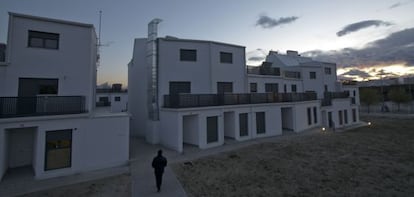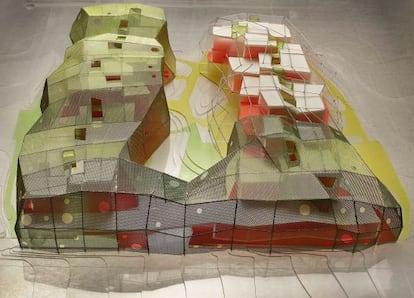No more changes of plan
Court tells Madrid City Hall to redo housing project after it altered the original design


What did the Madrid Municipal Housing and Land Company (EMVS) ever want with two of the best architects around? Two years ago, José Selgas and Lucía Cano, designers of the conference halls in Badajoz and Cartagena, ended up filing a complaint against the organization. They had spent weeks battling with a constructor who refused to put up a building in the Ensanche de Vallecas development in southeast Madrid according to the approved plans.
For them, it wasn't a question of art but rather one of justice. The duo were fired by the EMVS agency and another architect built over the structure. Now, however, a court has ordered EMVS to complete the work according to Selgas and Canos' original plans.
Redoing a project that has modified a property is normal in heritage matters, but there is no precedent for rectifying one from a design that has not yet been built. But the decision also upholds something more basic: the impossibility of unilaterally modifying a contract.
The ruling has opened up a murky world that few are daring enough to uncover. Many say the practice of not allowing architects - commissioned to create buildings that have been approved, put out to tender and awarded to buyers - to complete their projects has been going on for years. Why don't the architects kick up a fuss? "Possibly out of fear of losing future commissions," says José Selgas.
His partner Lucía Cano admits she wouldn't have filed a complaint. "I thought it was a waste of time and money and meant clashing with the EMVS, which, after all, is a potential client."
The Ensanche 53 project at number 44, Embalse de Manzanares street is fenced off. A security guard says seven of the 20 apartments have been allocated. More anodyne than humble, the development is a long way from what you would expect of architects who received the commission after winning the Madrid region's architecture prize for other social housing projects carried out for EMVS. The uninhabited property is also a long way from the vanguard architecture that, a few months ago, EMVS director of projects and works, Miguel Ángel Prieto, defended in this newspaper.

Neither does it seem original - the mesh of plants that buyers such as David Sagredo, Rosa María Recio and José Antonio Vime had planned to watch grow with their families is absent. Nevertheless, the EMVS continues to publicize the development, now the work of the architect Rafael Carrasco, using the description of the original project that comprises "a mesh of plants that works to completely cool the complex and large window panes that in winter are warmed by sunlight."
The mesh was no mere decoration. It was the key element of the Selgascano project. And it was also the cause of the disagreement between the builders, civil servants and architects. Budgeted at 600,000 euros, the development has now been built without it "in a version that turns the original project into a shantytown," says Selgas.
No money has been saved by the change, however. That was a key part of the trial. "Where has that money ended up?" asks Selgas.
Ángel Alonso and Victoria Acebo, who were awarded a prize at the Spanish Architecture Biennale in 2007, also have a project for the construction of "at least" 60 houses on hold in Madrid's Villaverde Bajo neighborhood. The EMVS wanted to bring together the best: "Madrid is an international leader in avant-garde architecture," the organization says. Alonso and Acebo's commission was for 40 apartments on Calcio street. They delivered a final design that was approved and paid for. Then the structure of the EMVS changed and so did their luck.
"They ordered us to modify 75 percent of it," they say. "They were asking for things that weren't in the contract, pressurizing us by saying we wouldn't be commissioned for the rest of the properties.
"We have refused to be threatened into working for free."
They suspect the EMVS will change the project itself. But this means that "it is not on hold; it is waiting to be put out to tender." This all happened two months ago. They have decided to look for lawyers.
Jaime Coll and Judith Leclerc preferred to turn the page. They also won a prize at the Biennale and after a string of disasters their project was reallocated to Eduardo González Ruiz, who EMVS supervisor Luis Gómez describes as "a completely trustworthy, skilled, expert friend of mine, who quickly sorts out the troubled projects of architects such as you," quotes Coll reading out Gómez's letter. On the EMVS website González features as a co-author of the development, "even though we haven't even seen the final project."
Other architects describe irregular situations but end up asking to remain anonymous. That is the case of some who won a recent competition just after finishing their degree. They talk about the EMVS as an "extremely arrogant" client. They prefer not to be named "because having any problem would complicate its dealings with the EMVS."
Prieto, from EMVS, said he has "no record of any of the cited cases" and referred EL PAÍS to its press department. He explains that the "Selgascano project was modified because it did not comply with legal requirements" but did not offer an opinion on the recent ruling made against the organization.
Alonso says the EMVS uses "its quality control office to apply the pressure," adding that he "wouldn't work for them again. The EMVS extorts you in order to change the project when they want and if you don't do it, they do." Other creators of social housing, such as Emiliano López and Mónica Rivera in Barcelona, question where the thin line that separates authorship and service lies. "I don't think that the recognition of our role in society should pass through the courts," they say.
But Alonso replies: "We are not kicking up a fuss because they changed our little drawings, not even so that they allow us to design decent housing. It is because it is not legal for the owner to modify an approved project."
Art or justice? The will to marry the most humble architecture with the best design cannot be more interested in the names than in the design. In that contradiction the lawyers are now finding their role.
The ruling against the EMVS will help architects overcome their fear in the face of the pressures. Selgascano has no idea whether the current building will be destroyed or not - "we would feel bad leaving 20 families without a home and squandering public money" - but their lawyers confirm that the terms of the ruling "could be carried out on another site."
Tu suscripción se está usando en otro dispositivo
¿Quieres añadir otro usuario a tu suscripción?
Si continúas leyendo en este dispositivo, no se podrá leer en el otro.
FlechaTu suscripción se está usando en otro dispositivo y solo puedes acceder a EL PAÍS desde un dispositivo a la vez.
Si quieres compartir tu cuenta, cambia tu suscripción a la modalidad Premium, así podrás añadir otro usuario. Cada uno accederá con su propia cuenta de email, lo que os permitirá personalizar vuestra experiencia en EL PAÍS.
¿Tienes una suscripción de empresa? Accede aquí para contratar más cuentas.
En el caso de no saber quién está usando tu cuenta, te recomendamos cambiar tu contraseña aquí.
Si decides continuar compartiendo tu cuenta, este mensaje se mostrará en tu dispositivo y en el de la otra persona que está usando tu cuenta de forma indefinida, afectando a tu experiencia de lectura. Puedes consultar aquí los términos y condiciones de la suscripción digital.
Últimas noticias
The complicated life of Francesca Albanese: A rising figure in Italy but barred from every bank by Trump’s sanctions
How Japan is trying to avert ‘digital defeat’
Reinhard Genzel, Nobel laureate in physics: ‘One-minute videos will never give you the truth’
Pinochet’s victims grapple with José Antonio Kast’s rise in Chile
Most viewed
- Pablo Escobar’s hippos: A serious environmental problem, 40 years on
- Why we lost the habit of sleeping in two segments and how that changed our sense of time
- Trump’s obsession with putting his name on everything is unprecedented in the United States
- The Florida Keys tourist paradise is besieged by immigration agents: ‘We’ve never seen anything like this’
- Charles Dubouloz, mountaineering star, retires at 36 with a farewell tour inspired by Walter Bonatti








































